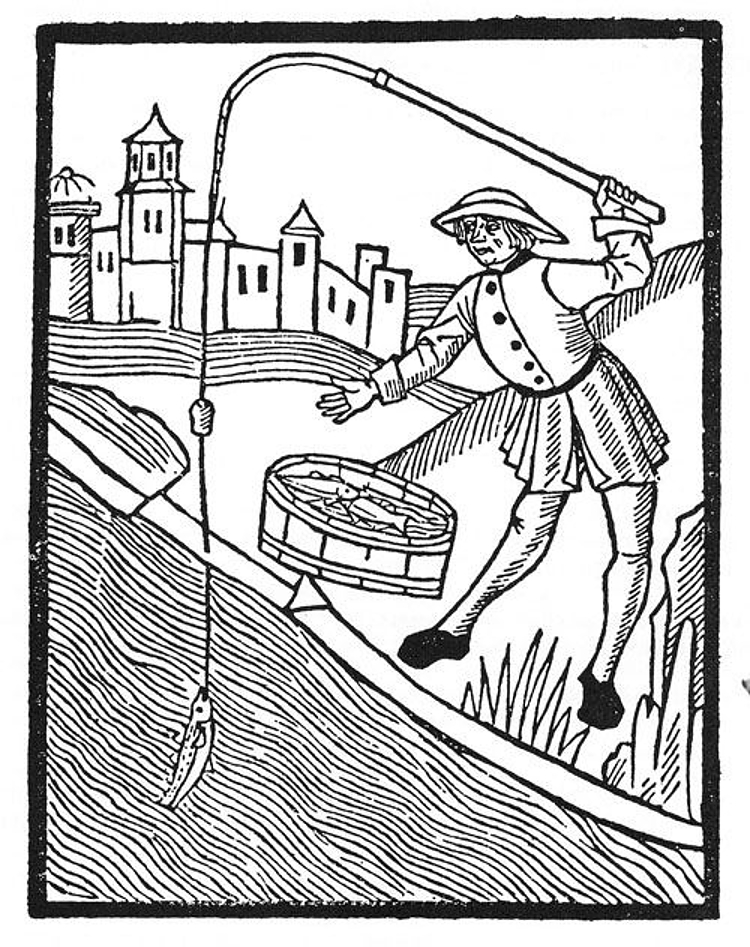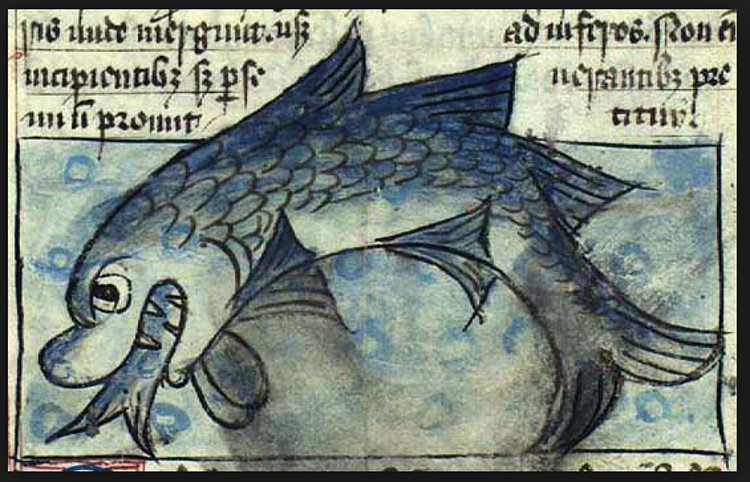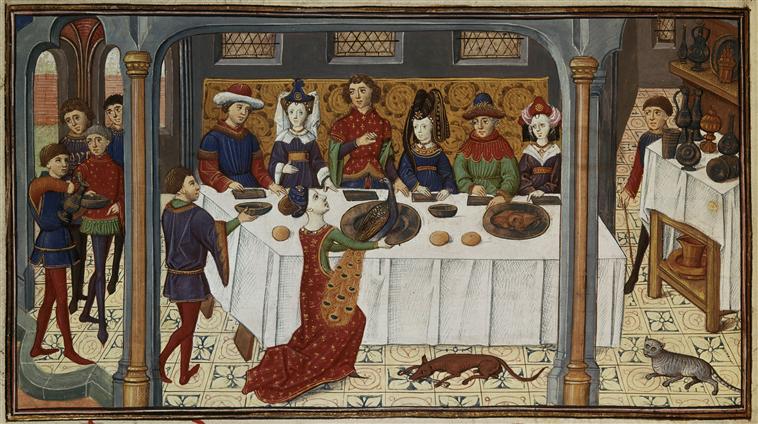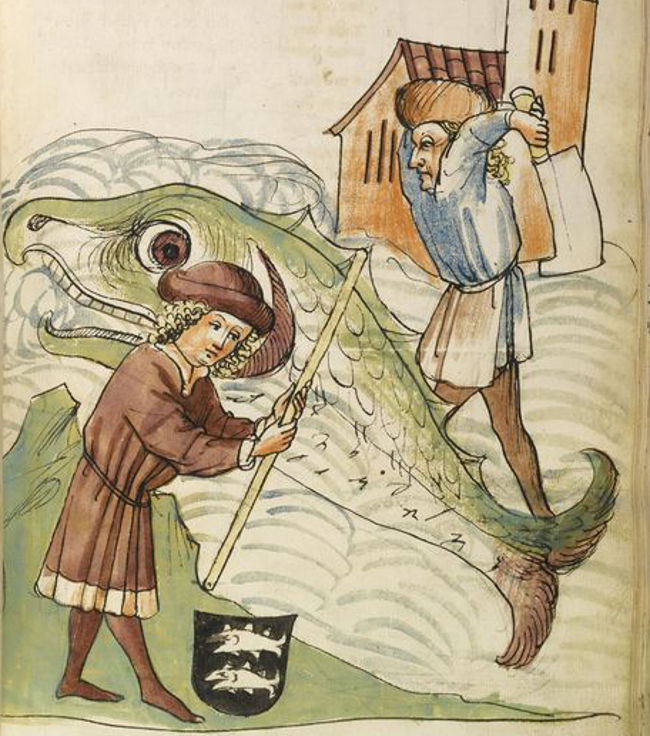 Austerity was not necessarily on the menu when it came to royal dining during Lent, even if meat was off limits. ‘Fish days’ were observed throughout the year on Fridays and Saturdays, and Wednesdays in some quarters. The Medieval and Tudor communities consumed a very wide variety of fish and seafood. A fishmonger’s stock might include oysters, crabs, trout, sprats, salmon, haddock, mackerel, codling, shrimps, red and white herring, whiting, ‘pickerelle’ [young pike], gurnards and tench. He would also sell stockfish, a dried and salted fish that took several days of soaking before it was edible, but kept well for long periods. The range of eels might include “strikes of pimpenelle”[small eels] lampreys and conga eel.1 The royal court also consumed sturgeon, whale, porpoise and things that were not actually seafood, such as puffins, barnacle geese and beaver tails. A fish day dinner menu from the reign of Henry VIII and his first queen Katherine of Aragon shows the staggering range of seafood consumed at court for the first main meal of the day.2
Austerity was not necessarily on the menu when it came to royal dining during Lent, even if meat was off limits. ‘Fish days’ were observed throughout the year on Fridays and Saturdays, and Wednesdays in some quarters. The Medieval and Tudor communities consumed a very wide variety of fish and seafood. A fishmonger’s stock might include oysters, crabs, trout, sprats, salmon, haddock, mackerel, codling, shrimps, red and white herring, whiting, ‘pickerelle’ [young pike], gurnards and tench. He would also sell stockfish, a dried and salted fish that took several days of soaking before it was edible, but kept well for long periods. The range of eels might include “strikes of pimpenelle”[small eels] lampreys and conga eel.1 The royal court also consumed sturgeon, whale, porpoise and things that were not actually seafood, such as puffins, barnacle geese and beaver tails. A fish day dinner menu from the reign of Henry VIII and his first queen Katherine of Aragon shows the staggering range of seafood consumed at court for the first main meal of the day.2
On a Fish Day
Dinner
Cheate bread and manchet,
Ale and beer,
Wine,
Herring,
Pottage,
Organe Lyng,
Poudred eels or lampreys,
Pyke,
Calver salmon,
For Fresh Salmon
Take your salmon and boil him in fair water, rosemary and thyme, and in the seething put a quart of strong ale into it. And let it boil till it be enough Then take it from the fire and let it cool. Then take your salmon out of the pan and put it in an earthen pan or wooden bowl, and there put so much broth as will cover him. Put into the same broth a good deal of vinegar so that it be tart with it.3
Whiting,
Haddocks, mullets, or bass,
Playce or gurnard,
Sea bream or soailes,
Congers, Door,
Porpoise, seal,

Furmente with Porpeys
Take clean wheat and beat it small in a mortar, and fan out clean the dust. Wash it clean and boil it till it be tender and brown. Take the second milk of almonds and boil them together until thick, and take the first milk and mix it together with a penne [whisk]. Take the porpoise out of the frumenty and slice him in a dish of hot water. Add saffron to the frumenty, and serve it forth.4
Carp, Trout,
Crabs, lobsters,
Fantastic crayfish or lobster tart
Take boiled crayfish and pull the flesh from the tails, and take a quantity of good herbs, and chop all well together and put with them almond milk, fine spices and currants. And of this batter make a thin tart between two crusts, and above the filling should be potent with sweet spices and currants, and the crust should be good and yellow.5
Custard,
Rascals, or Flage,
Tart closed,
Fritter,
Fruit

Second Course
Second pottage
Sturgeon pr’ vel r’,
Byrt or other dish,
Bream or other dish,
To Boil a Bream
Take white wine and out it in a pot and let it seethe. Then take your bream and cut him up in the midst and put him in. Take an onion and chop it small. Then take nutmegs beaten, cinnamon and ginger, whole mace and a pound of butter and let it boil together. So season it with salt, serve it upon sops[cubes of stale bread] and garnish with fruit.6
Tench,
Perch, or other dish,
Eels with lampreys roast
Laumpreys in Galyntyne
Take Lampreys and slay him with vinegar or with white wine and salt. Scald him in water. Slit him a little at the navel and rest a little. Take out the guts at the end. keep well the blood. Put the Lamprey on a spit. Roast him and keep well the grease. Grind raisins of coraunce;7 draw him up with vinegar, wine and crusts of bread. [Season with] powder of ginger, of galangal, flour of canel [cinnamon], powder of cloves and whole raisins; with blood and grease. Salt it and simmer […]. Serve on a fish platter, dress with juices and serve him forth.8
Chynes of salmon broiled,
Crevez,
Shrimp,
Tart,
Fritter,
The Best Fritters
To make the best fritters, take a pint of cream and warm it; then take eight eggs, only abate four of the whites, and beat them well in a dish, and so mix them with the cream; then put in a little cloves, mace, nutmeg and saffron, and stir them well together: then put in two spoonfuls of the best ale barm,9 and a little salt, and stir it again, then make it thick according unto your pleasure with wheat flour; which done, set it within the air of the fire, that it may rise and swell; which when it doth, you shall beat it in once or twice, then put it into a penny pot of sack: All this being done, you shall take a pound or two of very sweet seam, and put it into a pan, and set it over the fire, and when it is molten, and begins to bubble, you shall take the fritters-batter, and setting it by you, put thick slices of well pared apples into the batter, and then taking the apples and batter out together with a spoon, put it into the boiling seam, and boil your fritters crisp and brown: And when you find the strength of your seam consume or decay, you shall renew it with more seam: and of all sorts of seam, that which is made of the beef-suet is the best and strongest: when your fritters are made, strew good store of sugar and cinnamon upon them, being fair dished, and serve them up.10
Fruit,
Baked Pippins, Oranges
Butter and eggs

Note: spelling been modernised.
- Wilson, C. Anne, Food and Drink in Britain: From the Stone Age to Recent Times, Penguin, 1984, pp. 37 ↩
- A collection of ordinances and regulations for the government of the royal household, made in divers reigns : from King Edward III to King William and Queen Mary, also receipts in ancient cookery,Society of Antiquaries of London, 1790, pp174 <online: https://archive.org/details/collectionofordi00soci>> ↩
- Dawson, Thomas, The Good Housewife’s Jewel, Southover Press 1996, pp. 29 ↩
- Pegg, Samuel, The Forme of Cury, The University of Adelaide Library, University of Adelaide,2005, pp.165 ↩
- de Birkestad, Helewyse(translator), Libro di cucina/ Libro per cuoco (14th/15th c.) (Anonimo Veneziano),<online: http://helewyse.medievalcookery.com/libro.html#XCVII>(accessed March 2016) ↩
- Dawson, Thomas, The Good Housewife’s Jewel, Southover Press 1996, pp. 26 ↩
- Raisins or currants may have been used ↩
- Butler, Sharon, Hieatt, Constance B., (editors) Curye on Inglysch: English Culinary Manuscripts of the Fourteenth Century, Early English Text Society, Oxford University Press, 1985 ↩
- Foam ↩
- Markham, Gervase, Best, Michael R.,(editor) The English Housewife, McGill-Queen’s University Press, 2013, pp. 68 ↩

